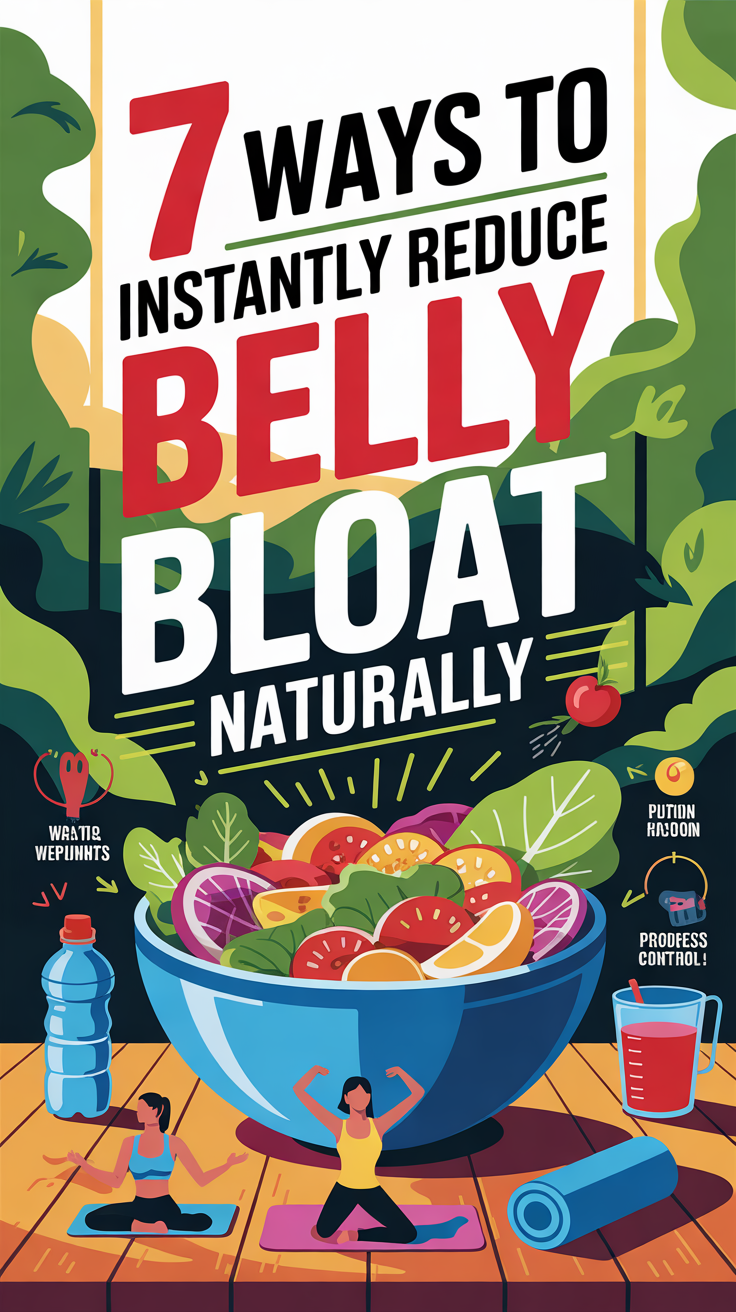7 Ways to Instantly Reduce Belly Bloat Naturally
You can quickly reduce belly bloat through seven evidence-based methods: sipping peppermint tea to relax digestive muscles, performing gentle clockwise abdominal massage to stimulate peristalsis, practicing targeted yoga poses like Wind-Relieving Pose, taking a 10-15 minute post-meal walk, eating mindfully with thorough mastication, incorporating natural digestive aids like bromelain-rich pineapple, and maintaining optimal hydration levels throughout the day. These clinically-supported interventions can provide relief within minutes, with deeper benefits emerging through consistent application.
Key Takeaways
-
Sip peppermint tea after meals to relax digestive muscles and reduce bloating, showing up to 40% reduction in symptoms.
-
Perform gentle clockwise abdominal massage following the colon’s natural path to stimulate digestion and relieve gas.
-
Take a 10-15 minute walk after meals at a comfortable pace to accelerate digestion and release trapped gas.
-
Practice mindful eating by chewing thoroughly and removing distractions to prevent excess air swallowing.
-
Apply pressure to Zhongwan point (four fingers above navel) in circular motions for immediate bloating relief.
Sip on Peppermint Tea for Quick Digestive Relief
When digestive discomfort strikes, peppermint tea can step in as a natural therapeutic solution. This time-tested remedy works by relaxing your digestive system’s smooth muscles, effectively addressing common bloated belly symptoms like gas and indigestion. Clinical studies demonstrate peppermint’s significant impact on digestive health, with research showing a 40% reduction in IBS symptoms compared to 24.3% with placebo treatments. Moreover, this natural remedy targets root causes of bloating by facilitating digestion and gas release. To maximize peppermint tea’s therapeutic benefits, steep fresh or dried leaves in hot water and consume after meals. The compounds in peppermint stimulate bile flow, enhancing fat breakdown during digestion. However, if you’re dealing with GERD or acid reflux, exercise caution as peppermint may exacerbate these conditions. The tea’s essential oils like menthol make it particularly effective at soothing digestive issues. For optimal results, incorporate this natural bloated belly remedy consistently into your digestive health routine.
Practice Gentle Abdominal Massage Techniques
You’ll find significant relief from bloating by performing gentle abdominal massage in a clockwise direction, which follows your colon’s natural path and stimulates peristalsis. Engaging in this practice can promote better digestion and reduce the discomfort associated with excessive sodium intake. Key pressure points along the ascending, transverse, and descending colon respond well to circular motions using moderate finger pressure, particularly focusing on the ileocecal valve area in the lower right quadrant. Enhance your massage’s effectiveness by incorporating therapeutic-grade essential oils like peppermint or ginger, which can penetrate the tissue and provide additional anti-spasmodic benefits. The proven I Love U technique serves as an effective pattern to follow when massaging your abdomen for optimal results.
Clockwise Massage Motion Benefits
A clockwise abdominal massage technique offers significant therapeutic benefits for digestive health and bloating relief. By performing small, circular motions from your appendix to sigmoid colon, you’ll facilitate optimal colon clearance and enhance gut motility.
You’ll achieve maximum benefits by maintaining this motion for 10 minutes, starting with gentle pressure for the first three minutes before gradually increasing intensity.
The technique helps reeducate your bowel muscles while promoting stool movement through the colon. Ensure you rest on your back with knees bent and supported by a pillow for proper positioning.
It’s particularly effective at reducing abdominal tightness, cramping, and bloating symptoms.
This evidence-based approach also triggers your body’s relaxation response, reducing stress levels and tension between organs and surrounding tissues. While it won’t cure conditions like IBS, you’ll experience improved symptom management through regular practice of this complementary therapy.
Pressure Point Relief Areas
Building on the clockwise massage technique, specific pressure points offer targeted relief for abdominal discomfort.
Begin with Zhongwan (CV12), located four fingers above your navel, applying gentle circular pressure to ease bloating and acid reflux.
Next, target Zusanli (ST36), found three inches below your kneecap, to enhance digestive function and reduce gas.
For comprehensive relief, stimulate Sanyinjiao (SP6) on your inner lower leg, about four fingers above the ankle bone.
This point activates your parasympathetic nervous system, supporting natural digestion.
Don’t forget the point two fingers below your navel and the forearm point three fingers below your elbow crease.
Apply firm but comfortable pressure to each point for 2-3 minutes, stimulating meridian pathways that regulate digestive organ function.
Traditional Chinese medicine recognizes that these points work along energy meridians to influence your metabolism and digestion.
Essential Oils for Massage
Essential oils offer potent therapeutic benefits when combined with gentle abdominal massage techniques.
When mixed with carrier oils like sweet almond or apricot kernel, these concentrated botanical extracts can enhance digestive function and reduce bloating through their anti-inflammatory properties.
Select therapeutic-grade oils proven to support gastrointestinal comfort:
- Peppermint oil: Contains menthol compounds that relax smooth muscle tissue and ease digestive distress
- Basil oil: Rich in linalool, known for its antispasmodic effects on the digestive tract
- Tarragon oil: Provides carminative properties that help reduce gas and bloating
Apply these oils diluted in a clockwise motion across your abdomen while lying down. For optimal results, gently press and massage reflex points for 3 minutes after meals to enhance digestive comfort.
This technique stimulates peristalsis, the natural wave-like muscle contractions that move food through your digestive system, maximizing the aromatherapeutic benefits for optimal relief.
Try These Simple Yoga Poses for Better Digestion
Five scientifically-supported yoga poses can help reduce digestive discomfort and bloating through targeted compression and gentle manipulation of abdominal organs.
Wind-Relieving Pose stimulates peristalsis and releases trapped intestinal gas via controlled compression cycles.
Virasana enhances blood flow to digestive organs while reducing bloating through seated compression.
The Supine Spinal Twist detoxifies your digestive tract and stimulates liver function through gentle torsion.
Frog Pose activates your parasympathetic nervous system and enhances enzyme secretion via targeted abdominal pressure.
Finally, Seated Forward Bend optimizes digestive efficiency by stimulating the vagus nerve and creating a squeeze-release action on intestinal organs. Incorporating gentle movement into your routine, such as these yoga poses, can further support a healthy digestive system.
Each pose requires 10-15 minutes of practice for optimal therapeutic benefits.
Stay Active With a Post-Meal Walk
When you’re experiencing uncomfortable bloating, a post-meal walk can accelerate gas movement through your digestive tract for quick relief.
Your walking motion stimulates peristalsis, the natural muscular contractions that propel food and gas efficiently through your gastrointestinal system.
The increased blood flow from walking also enhances your digestive processes, helping to break down food more effectively and reduce bloating symptoms. Additionally, this practice aligns with the concept of gentle abdominal massage, which supports natural digestive processes and aids in releasing trapped gas.
Walking Speeds Gas Relief
Taking a short walk after meals provides significant relief from intestinal gas and bloating through enhanced digestive transit.
Research shows that a moderate 10-15 minute walk at 3 mph stimulates gastric emptying and encourages the release of trapped intestinal gas.
This physical activity triggers abdominal muscle contractions that help move food and gas through your digestive tract efficiently.
- Studies demonstrate walking’s effectiveness matches prokinetic medications for bloating relief
- Post-meal walking reduces symptoms by 50% in IBS patients
- Movement-induced muscle contractions accelerate gastric emptying into the small intestine
You’ll maximize benefits by maintaining a brisk but comfortable pace that elevates your heart rate without causing breathlessness.
This approach supports optimal digestion while preventing the discomfort that can occur with more intense exercise immediately after eating.
Movement Aids Digestion Fast
Looking to speed up your digestion naturally? Post-meal walking stimulates crucial gastric and intestinal contractions that accelerate food transit through your digestive tract. When you walk after eating, you’re activating a coordinated series of muscle movements from your esophagus to your colon, optimizing the enzymatic breakdown of nutrients.
You’ll achieve maximum digestive benefits by walking for just 2-15 minutes immediately after your meal.
Maintain a light to moderate pace – intense exercise isn’t necessary and may disrupt digestion.
This timing aligns perfectly with your postprandial blood sugar rise, typically occurring within 30-60 minutes of eating.
Studies show that multiple short walks outperform single longer walks for both digestive health and glycemic control, making this an evidence-based strategy for reducing gastrointestinal discomfort.
Mindful Eating: Slow Down and Chew Thoroughly
Mindful eating represents a scientifically-validated approach to reducing belly bloat through enhanced digestive efficiency.
When you slow down and chew thoroughly, you’re activating critical digestive enzymes while simultaneously reducing the formation of intestinal gas that contributes to abdominal distention.
- Practice thorough mastication of each bite, which optimizes the mechanical breakdown of food particles and improves nutrient absorption.
- Remove environmental distractions during meals to maintain focus on proper eating mechanics and internal satiety cues.
- Engage your sensory awareness to fully experience food textures and flavors, promoting optimal vagal nerve stimulation.
Clinical research demonstrates that mindful eating techniques reduce bloating symptoms through improved digestion, decreased aerophagia, and enhanced gastric motility. Additionally, this approach supports a healthy balance of gut bacteria which is essential for preventing bloating.
This evidence-based strategy also supports long-term weight management and metabolic health through improved glucose regulation.
Choose Bloat-Busting Foods and Herbs
Strategic selection of anti-bloating foods and herbs can significantly modulate gastrointestinal function and reduce abdominal distention through multiple physiological mechanisms.
You’ll find potent enzymatic support in pineapple’s bromelain and papaya’s papain, which optimize protein digestion.
Natural diuretics like celery, asparagus, and cucumber help eliminate excess fluid retention, while ginger and turmeric provide anti-inflammatory benefits. Ginger is particularly effective due to its capacity to reduce intestinal inflammation and help expel excess gas.
For optimal results, incorporate dark berries rich in antioxidants and soluble fiber sources like oats and barley.
Herbal interventions such as peppermint, fennel, and chamomile can effectively relax gastrointestinal muscles and reduce gas formation.
Consider supplementing with therapeutic beverages including green tea, ginger tea, or warm lemon water to stimulate digestive secretions and enhance gut motility.
Hydrate Smart: The Right Way to Drink Water
Beyond the beneficial effects of digestive herbs and foods, proper hydration stands as a fundamental mechanism for reducing abdominal bloating.
When you’re dehydrated, your body retains fluid, leading to visible abdominal distention and digestive inefficiency.
Clinical evidence demonstrates that adequate water intake optimizes digestive function and prevents fluid retention.
- Consume eight 8-ounce glasses of water daily, distributed throughout your waking hours
- Replace sugary beverages and excessive caffeine with water or unsweetened tea
- Monitor hydration status through urine color and frequency
Your body’s cellular functions depend on proper hydration to maintain electrolyte balance and facilitate waste elimination. Moreover, proper hydration is crucial for maintaining healthy bowel movements, as dehydration can slow down the digestive process.
By maintaining consistent water intake, you’ll reduce constipation risk, support efficient digestion, and minimize bloating symptoms.
Regular hydration also helps distinguish true hunger from thirst, preventing unnecessary food consumption that could exacerbate bloating.
References
- https://www.brighamandwomens.org/patients-and-families/meals-and-nutrition/bwh-nutrition-and-wellness-hub/special-topics/gas-beat-the-bloat
- https://www.medicalnewstoday.com/articles/322525
- https://www.health.harvard.edu/staying-healthy/how-to-get-rid-of-bloating-tips-for-relief
- https://www.healthline.com/nutrition/proven-ways-to-reduce-bloating
- https://naturemed.org/the-best-natural-remedies-for-bloating/
- https://www.bbcgoodfood.com/health/nutrition/health-benefits-peppermint-tea
- https://www.healthline.com/nutrition/peppermint-tea
- https://www.webmd.com/diet/mint-tea-health-benefits
- https://www.verywellhealth.com/peppermint-tea-8420406
- https://thocc.org/about/news-press/news-detail?articleId=60994&publicid=461

